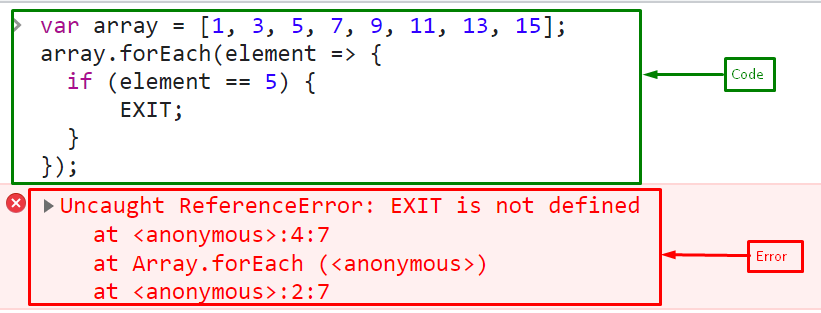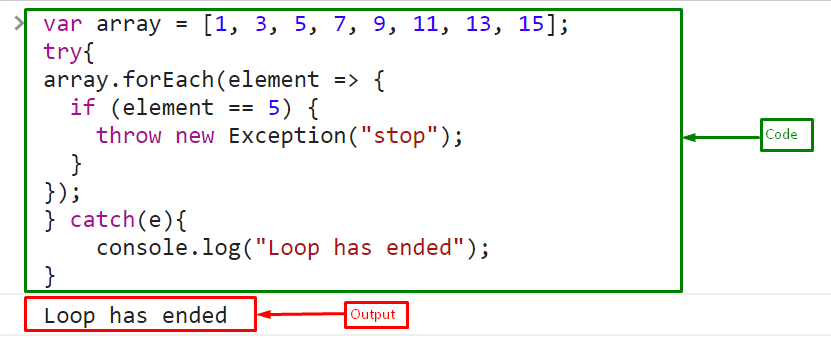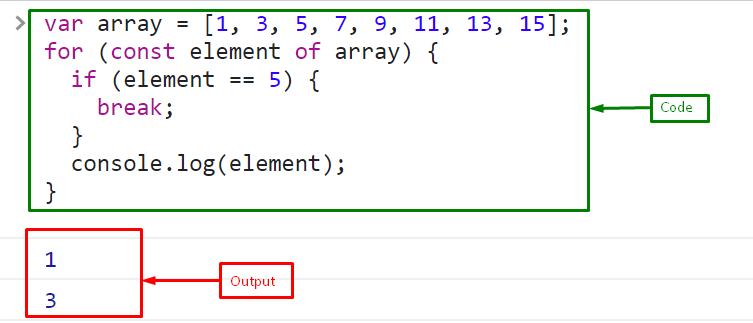This article will describe the procedure for stopping the forEach loop in JavaScript.
How to Stop JavaScript forEach?
Depending on the program’s specific needs, there are several ways to stop a loop in programming. For example, you might use a loop termination condition or a break statement such as “break” or the “EXIT” to stop the loop when a certain condition is met. However, the problem is this, the “forEach” loop throws an error while using these statements.
Example 1: Use “break” in forEach JavaScript Loop
Let’s try to stop the “forEach” loop using the “break” statement. First, create an array of odd numbers:
Use the forEach loop to iterate the array. If the element “5” occurs in an array during iteration, stop the loop:
if (element == 5) {
break;
}
});
It can be seen that the break statement is not working in the forEach loop:

Example 2: Use “EXIT” in forEach JavaScript Loop
Try to stop the loop using “EXIT” when the element “5” occurs in an array during iteration:
if (element == 5) {
EXIT;
}
});
It also causes an error:

Stopping a forEach() loop appears to be an impossible challenge, but here are a few solutions to evaluate:
Method 1: Stop JavaScript forEach Using “try/catch” Block
There is no built-in way to stop or break a forEach() loop in JavaScript. However, you can achieve a similar effect by throwing an exception and catching it within the loop. To do this, use the “try/catch” block. It is a control structure that allows you to handle exceptions, or runtime errors, that may occur in code. The code that may cause an exception is found in the “try” block, whereas the code that handles the exception is contained in the “catch” block.
Syntax
Use the below-given syntax for using the try/catch block:
// code that may throw an exception
} catch (error) {
// code to handle the exception
}
Example
Wrap the forEach() loop code in the try/catch block to stop the loop by handling the error:
array.forEach(element => {
if (element == 5) {
throw new Exception("stop");
}
});
} catch(e){
console.log("Loop has ended");
}
In the above code snippet, when an exception is thrown within the try block, the program will immediately jump to the catch block and execute the code there. This gives us the ability to manage the exception and protect the program from crashing.
Output

It is generally not recommended to use a try/catch block to stop a forEach() loop in JavaScript. This is because the purpose of a try/catch block is to handle exceptions rather than to control the flow of a loop. So, it’s better to use alternative methods.
Method 2: Use the “for” Loop in JavaScript
Use the “for” loop instead of the forEach() loop. The break statement is used in the for loop, allowing for an early exit before the loop termination condition is reached. This can be useful if you want to stop the loop when a certain condition is evaluated as “true” or exit the loop for any other reason.
Syntax
Follow the following syntax for using the “for” loop:
//condition
break;
}
Example
Use the “for” loop to iterate the array until its length and stop the array while the occurrence of element “5” in an array:
const element = array[i];
if (element == 5) {
break
}
console.log(element);
}
The loop stops when the “5” appears in an array:

Method 3: Use the “for-of” Loop in JavaScript
You can also use the “for-of” loop as an alternative to the forEach() loop. It is used to loop through the elements of an iterable object, such as an array or string. It is similar to the for-in loop but is specifically designed to work with iterable objects and is generally considered more concise and easier to read.
Syntax
The following syntax is utilized for the for-of loop:
//condition
break;
}
Example
The for-of loop is used here to iterate the array and stop the iteration when the element “5” appears in an array during iteration:
if (element == 5) {
break;
}
console.log(element);
}
Output

That’s all about stopping the forEach() loop in JavaScript.
Conclusion
There is no built-in way to stop or break a forEach() loop in JavaScript. But you can achieve a similar effect using the “try/catch” block. However, it is not recommended to use because a try/catch block is to handle exceptions rather than to control the flow of a loop. So, the ideal approach is to utilize alternative methods, such as the “for” or the “for-of” loop. In this article, we described the procedure for stopping the forEach() loop in JavaScript.
